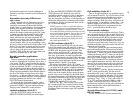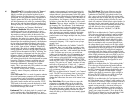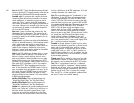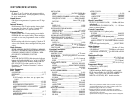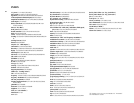Load In the DX7, "Load" describes the process of trans-
ferring the 32 voices from one bank of a ROM cartridge,
or from a RAM cartridge, into the 32 internal memories.
MIDI This is an acronym for Musical Instrument Digital
Interface, a specification which several manufacturers
have already agreed to use for designing equipment
which is compatible. MIDI is a non-proprietary "lan-
guage" which allows different (or identical) synthesizers
to "talk" to each other. MIDI-compatible instruments
made by any one manufacturer should generally be
capable of causing other manufacturers' MIDI-compati-
ble instruments to play, and to switch from one voice to
the next. Computer or sequencer control of multiple
synthesizers will be possible using MIDI. Within a single
manufacturer's product line, such as the Yamaha DX
series, MIDI can permit extensive programming of one
instrument through the controls of another by com-
municating so-called "system exclusive" information;
when dissimilar synthesizers are fed this type of infor-
mation, they simply ignore it.
Modulation This is the process of varying one signal
with another. See "Frequency Modulation."
Modulation Index This refers to the ratio between the
output level of a modulator and the level of the carrier
which it is modulating. The greater the modulation
index, the more harmonics are produced (the wider the
bandwidth of the FM-generated complex tone). When
you turn up the level of a modulator, you increase the
modulation index.
Modulator In general terms, this is the circuit which
allows one signal to modulate another. In the DX syn-
thesizers, a modulator is an operator which sends its
signal to another operator (either another modulator or a
carrier) rather than directly to the output. The only thing
that differentiates a modulator from a carrier is its posi-
tion within the algorithm; carriers are on the bottom
row of the stack(s) and modulators are above them.
OP This is an abbreviation; see "operator."
Operator This is a functional block within the circuitry
of the DX synthesizer. An operator can be thought of as
an oscillator, but it is somewhat more complex. It is
actually a digital sine wave oscillator which includes a
digital envelope generator. The frequency and output
level of an operator are adjustable. Operators actually
have multiple inputs so that they can be fed signals from
more than one source (i.e., an operator serving as a
carrier may accept signals from two or three modula-
tors). The DX7 has 6 operators, all identical.
Parameter In general terms, a parameter is any defin-
able characteristic of a device or system. In the DX syn-
thesizers, "performance parameters" refer to those
characteristics of the instrument that, when adjusted
from the FUNCTION mode, affect the overall keyboard
— or at least affect more than a single voice. For exam-
ple, adjusting the keyboard's pressure sensitivity (After
Touch) is considered to be a "performance parameter"
because it affects any voice which is programmed to be
modulation sensitive. "Editing parameters" refer to those
characteristics that can be programmed for an individual
voice when the instrument is in the EDIT mode (such as
the choice of an algorithm).
PLAY mode In the DX7, this is the operating mode
from which you can select and play voices stored in a
cartridge or an internal memory. You select PLAY mode
by pressing either [MEMORY SELECT-INTERNAL]
OR [MEMORY SELECT-CARTRIDGE].
PMD This is an abbreviation for "Pitch Modulation
Depth." Higher PMD values apply more LFO modulation
toward changing the pitch of a voice when you play a
note, provided the [MODULATION SENSITIVITY-
PITCH] setting is greater than zero.
Preset A preset is a voice which can be played without
having to be programmed. Some synthesizers force the
player to program any voice which is to be played.
Other instruments have only factory presets — basically
fixed, unalterable voices. Still other synthesizers offer a
combination of programmable and preset voices. The
DX synthesizers go a step further. They offer complete
programmability plus presets (in the form of internal and
cartridge memories on the DX7), but the presets are,
themselves, completely programmable. Because the DX
preset voices can be edited, a better term might be "pri-
mary voices." Yamaha uses the term "preset" only
because it is familiar to synthesists, and the DX series
require enough new terminology without coining
another new term.
RAM This is an acronym for "Random Access Memory"
In computers, RAM is the "main memory" the solid state
area where programs are stored while they are active,
and where data is temporarily stored until it is trans-
ferred to secondary storage such as a floppy disk, hard
disk, magnetic bubble memory or magnetic tape. Such
computer RAM memories are ususally categorized in
terms of how many bytes of 8 bits each they can store; a
1K RAM holds about 1,000 bytes (actually 1K is 1,024
bytes). In the DX synthesizers, RAM does not refer to the
internal memory (although that is, in fact, a RAM mem-
ory). Instead, the term refers to an electronic secondary
memory — the EEPROM cartridge — and its size is
defined not in bytes, but in voices. The RAM cartridges
each hold 32 voices. The RAM cartridges are truly ran-
dom access memories since each voice can be written to
or read from the cartridge independently of the others,
or all 32 voices may be moved at once. However, the
DX7 RAM cartridges differ from conventional RAM in
that the cartridges retain their memory after power is
turned off, without the use of backup batteries.
Release In a synthesizer, this is the time it takes for the
note to die away after you let go of the key In the DX7,
rate 4 of the envelope is equivalent to the release rate;
the release time will depend on the level at the moment
the key is released, since, for a given rate. the time is
greater if the level is greater.
ROM This is an acronym for "Read Only Memory." In
computers, ROM is generally provided for storage of
small to medium sized, often-used programs such as
self-test routines, BASIC language, input/output drivers,
and so forth. ROM is generally provided on 1C chips that
cannot be altered. In the DX7, the factory "preset" voices
are stored in ROM chips inside the ROM cartridges.
Each of these cartridges holds 64 voices. Simple ROM
chips can only be programmed at the time of manufac-
ture, like those in the DX7 voice ROM cartridges. Semi-
ROM chips can be programmed after their manufacture
by using special equipment; these are known as PROMS
(Programmable Read Only Memories). Some PROMs
can also be erased (usually by exposure to ultra- violet
light) and can then be reprogrammed; these are known
as EPROMs (Eraseable Programmable Read Only Memo-
ries). Finally, some EPROMs are electrically eraseable so
that they can be reprogrammed easily without special
equipment; these are called EEPROMs (Electrically
Eraseable Progrmmable Read Only Memory) — and
Yamaha calls them RAM in the DX7, although they
differ from conventional RAM (see RAM definition).
EEPROMs may also be called EAROMs (Electrically
Alterable Read Only Memories).
Sample and hold This is a random "waveform." It
jumps from one level to another in a non-periodic fash-
ion, unlike the regular, uniform changes in level asso-
ciated with sine, sawtooth, square or triangle waves. In
the DX synthesizers, a sample and hold signal may be
selected for use in the LFO section.
61




